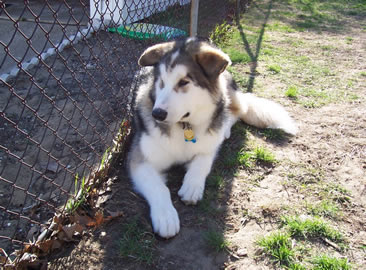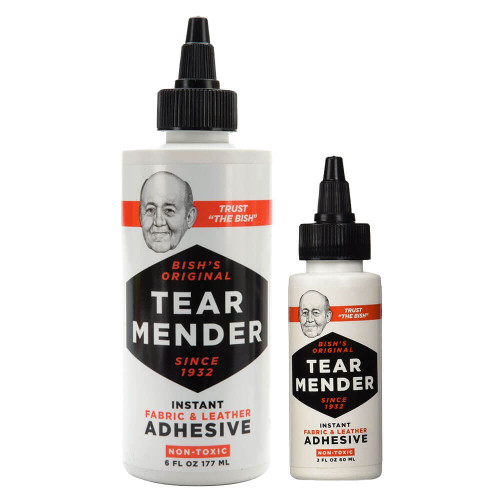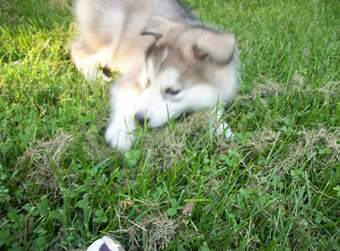Floppy Ears
Malamute puppies are born with ears folded over and they typically are erect by 6 months of age. We've had ears that were erect at 3 weeks and others that took much longer. Ears typically will go up and down randomly until they are fully erect. Sometimes an ear will "stall" halfway up - while the other is up or down. Max's ears were quite floppy, but over couple weeks time they started going up and down and then finally just stayed up. So there is no "rule" for when or how fast ears go up. Some puppies go up quickly and stay up - others can vacillate for weeks - sometimes months as to whether they want to stay up. Don't panic.
In the 1950's there was research done with the silver fox that equates floppy ears with a more domesticated temperament. I'm not sure if this is what is happening with our malamutes, but in the past few years I'm hearing more and more about ears that just don't "go up" on their own or are going up at later ages. Often this is attributable to certain genetic lines or sometimes larger ears. We've seen this in our breeding program too - our ears used to be up by 5-6 weeks but now it's taking as long as 13-15 weeks for some puppies. Can this be attributed to the fact that we are trying to mellow out and "domesticate" our malamutes more? I'm not sure... Of course we, as breeders need to think about what we may be doing to cause this new "problem". Perhaps we shouldn't be breeding puppies whose ears do not come up fast or on their own, unless they have some pretty outstanding qualities. Artificially propping them up until they'll stay up is quite common in other breeds - but do we want this in our malamutes? And how fast is too slow?
And yet...lets not go over the top...they're just ears!
I recently had a very disturbing call from a lady halfway around the world. Her Serbian malamute breeder was concerned because her 6 month old puppy's ears had not come up and she didn't know what to do. She had planned to show the dog, but regardless, her small children were in love with it. If it was never shown, she wouldn't mind, she was more than willing to spay her to keep from passing on any "bad genes" so she could keep the puppy as a Malamute. The puppy had become part of the family and was very loved. However, her "breeder" felt the need to demand the dog back so it could be put down. He considered it a "health problem". He didn't want to be embarrassed because he had produced floppy ears. Yes, you heard me right - PUT DOWN FOR FLOPPY EARS. Now, I feel it's important to breed to the standard which says upright ears are correct - but this "slaughter" by breeders to try and make themselves look good and to improve their lines is beyond my comprehension. While the cartilage may be weak, that is not a health problem - it's a structural problem. And a minor one at that.
I have heard that some breeders in Australia used to put down woolies because they were not correct. Woolies make great Malamutes. Nancy Russell of Storm Kloud Kennels once told us that it's important to have some woolies in your breeding program or you will lose proper coat! So it's easy, in a zest for "doing the right thing" to go TOO FAR. Perhaps this whole mind set started years ago with a history of killing whole litters of puppies to clear the parents of producing CHD (dwarfism). I'm not sure I understand why that was necessary rather than just spaying/neutering them and placing them in pet homes. While our dogs are CHD cleared due to the difficult decisions made by breeders before us, I'm not sure I could do that myself. Unless the puppy has a serious congenital defect that would preclude it from being a pet, why kill it when you can spay/neuter? Of course you wouldn't want these dogs in breeding programs, but to take a dog away from a loving family for it's ears? That seems just preposterous.
So, the dilemma...what to do when a pups ears take forever to come up or refuse to come up at all? Do we help nature or let it take it's course?
We've only had two puppies in all our years of breeding that had ears that didn't eventually come up by themselves, Nemo and Peke (just one ear in her case). Our best dog ever, Star, was our first dog with ears that were slow - as I recall, they came up around 14 weeks. Nemo was floppy eared as an adult and a fantastic pet, same with Peke. With a little help they might have come up, but his owner didn't care so we didn't worry about it. He was going to be neutered anyway.
But what if you have a floppy eared puppy, plan to spay/neuter, and would really like it to LOOK like a malamute (with upright ears)? Well, there are things you can do to help nature along. Dobermans and Shepherds use a method of taping the ears that can be tried. Often this won't work well with a malamute because they just won't leave it alone. So Malamute breeders that have problems in their lines with floppy ears have come up with other methods.
The one I've seen most often uses "moleskin" (available in the foot section of the drug store). Moleskin is a flannel covered foam pad that can 
 If it's only one ear you're having a problem with, first consider that perhaps she's sleeping on it when you don't realize it. Start paying attention to where and how she lays, and if she's crushing or folding the ear, make her move. Sometimes this is all you need to do when you have one slow ear.
If it's only one ear you're having a problem with, first consider that perhaps she's sleeping on it when you don't realize it. Start paying attention to where and how she lays, and if she's crushing or folding the ear, make her move. Sometimes this is all you need to do when you have one slow ear.
If that isn't your problem, and both ears are equally floppy and don't seem to be making any progress, perhaps you need to support them so the cartilage has a chance to firm up in the proper position. Sometimes support for just a few days or weeks is all that's needed. Sometimes it is just because the ear is heavy or larger. Often breeders will add unflavored gelatin to the puppy's food as a supplement for awhile. There is also an "old wives tale" that teething will make the ears flop...I'm not sure I agree with this...but I'm just letting you know about it. If you have any concerns, ask your breeder when their ears typically go up. It can vary tremendously from one line to another and your breeder is your best source of knowledge in this area.
If you decide the ears really do need some kind of structural support, it's time to get to work. The sooner and more consistently you support them, the better the chance for success. Using clippers, shave the inside of the ear so the moleskin will stick properly. Then, cut a piece of moleskin to fit just inside the ear all the way to the base. You want it wide enough so that it supports the entire ear and will make it stand. You'll want to cut and test before you stick it on permanently to make sure it fits right. Make sure it isn't too deep into the ear canal causing irritation. After you get the shape right, using some fabric glue (available at craft stores), lightly glue the moleskin into the ear. You may have to hold the puppy still for a bit until it dries. This creates a very flexible, but strong support for a floppy ear that is less likely to be pulled off. He may scratch at it at first, but it gives unlike the scaffolding used on other breeds. After awhile he will probably just forget about it, though you may end up gluing it back on a few times until he quits scratching at it or you get the hang of gluing it in well. It is also not nearly as obvious as the taped together contraption of Dobes and Shepherds. This is the way many mal breeders with large or floppy ears get them to come up.
 I suppose you could use the tape method, if your puppy will stand for it. My concern is it may curl the ear too much and may not have a natural appearance when removed. We've even used tiny barrettes for a week or two on wooly puppies whose ears were being pulled down by the weight of the hair. It's best to be pro-active - don't wait until the pup is so old a permanent crease forms in the ear. If it seems like it's just not going up, it doesn't hurt to give a little support just in case.
I suppose you could use the tape method, if your puppy will stand for it. My concern is it may curl the ear too much and may not have a natural appearance when removed. We've even used tiny barrettes for a week or two on wooly puppies whose ears were being pulled down by the weight of the hair. It's best to be pro-active - don't wait until the pup is so old a permanent crease forms in the ear. If it seems like it's just not going up, it doesn't hurt to give a little support just in case.
But if in the end you can't get them to go up - don't worry about it. He's still a Malamute and there is no need to put him down. You may have to fend off a few questions about him really being a malamute, but if you're like most of the Malamute owners I know, you'll love him just the way he is and learn to appreciate his forever sweet puppy look.
Nemo






